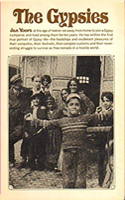
|
Folk Dance Federation of California, South, Inc.
|

|
CLICK AN IMAGE TO ENLARGE
I call Romani those who speak one or another of the dialects of Romany. Romany is an Indic language found outside of India. Some of the major groups of Rom are the following:
- Vlax: These Rom are probably found in all the countries of Europe and America. They speak a Romany language that has been loaned heavily from Romanian. (The term Vlax refers to the Romanian province of Wallachia.) There are quite a few sub-dialects in this group. Practically all those recognizable as Romani in North America are Vlax. These Romani call themselves Rom, which is a Romany word meaning "Gypsy man and husband." The best book on the Vlax dialect is "The Language of the Swedish Coppersmith Gypsy Johan Dimitri Taikon" by O. Gjerdman and E. Ljungberg (Uppsala, 1963, 455 pp). A very fine description of the culture of European Rom may be found in "The Gypsies" by Jan Yoors (New York, 1967, 256 pp). Yoors travelled with the Romani during his adolescence, and is the only non-Romani known to me who has learned the Romani culture thoroughly and from the inside. Additional information may be gleaned from "À la Découverte des Tsiganes" by Luc de Heusch (Brussels, 1965, 256 pp), which is a travelogue by a non-specialist.
- Manuš and Sinti: These travelling groups in France and Germany> form the subject of frequent articles in the journals listed below. Their dialect is related to that of the Rom, but is not intelligible to them. On the whole, these groups seem to be less cohesive than the Rom and to conform more to their non-Romani environment in such matters as religious ritual.
- British Romani: The great work on the language of the British Romani is John Sampson's "The Dialect of the Gypsies of Wales" (Oxford, 1926, 444 pp). This book is very important for the study of all the Romany dialects because it describes and discusses their common Indic core. Much descriptive material on the culture of British Romani is found in the volumes of the JGLS (see below).
- Spanish Romani: There are a number of different types of Romani in Spain, but I know nothing about any of them.
- Others: There are a variety of other groups of Romani in eastern Europe, the Balkans, Turkey, and the Near East. As far as I know, there is no good recent literature on them, though all the general sources on the Romani mention them. I have found the linguistic survey "Gypsy Studies, Part 1" by Jan Kochanowski (New Delhi, International Academy of Indian Culture, 1963, 448 pp) very helpful. Despite its title, this work is written entirely in French. The author is a (non-Vlax) Romani who speaks a Balkan dialect.
General Literature on the Romani
There are a great many books (perhaps thousands) that purport to describe the Romani. Some of these are in paperback, most have interesting pictures, but almost none can be recommended. Fortunately, however, there are two journals that, between them, will lead the student to all the important literature on the Romani. In addition to carrying many good original articles, these journals also make a practice of keeping their readers informed of everything else that is written about the Romani. (I must report, unfortunately, that neither of these journals has really critical standards, so that in addition to the good articles, the student will also find some material that is quite ridiculous!)
The first of these journals is the "Journal of the Gypsy Lore Society (JGLS)," published in England since 1888 and is now headquartered in the United States. (The Gypsy Lore Society, 5607 Greenleaf Rd., Cheverly, MD 20785)
The other journal is in French: "Études Tsiganes." Created in 1955. (L'Association des Études Tsiganes, 59 rue de l'Ourcq, 75019 Paris)